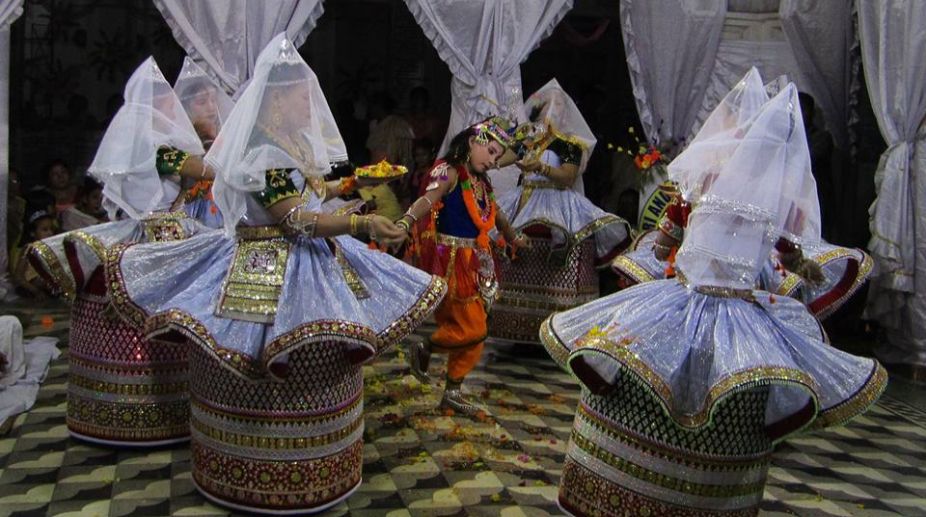Telling tales through movements
A bouquet of beautiful renditions showcased the varied bounty of Indian classical dance.

(Photo: Facebook)
It was an amazing experience to be present at the four-day Bhagyachandra Festival celebrated in the Anumahaprabhu Temple at Manipur Rajbari located in Nabadwip.
To commemorate the 219th death anniversary of the Saint King Rajarshi Bhagyachandra of Manipur, the legendary Ratan Thiyam took the initiative along with the Anumaprabhu Sebayet Samity. Rajarshi Bhagyachandra became a vaishnavite of Nabadwip and patronised by the then king of Nadia, Ishwarchandra, constructed this temple in 1793.
The festival showcased traditional dances, music, drama and held lectures highlighting the rich and strong link of culture between Manipur and Nabadwip as well as West Bengal. Inaugurated by the chief guest Yumnam Joykumar, deputy Chief Minister of Manipur the festival witnessed a variety of Manipuri performances by indigenous artistes of the hill state.
Advertisement
It is said that Bhagyachandra Maharaja established the temple of Anumahaprabhu known as Lord Govindo ji whose incarnation was thought to be the Gouranga Mahaprabhu as he saw in the dream to start worshiping Gouranga as well as Govondo openly during Muslim reign.
The enthusiasts from West Bengal and Manipur as well who gathered at the venue witnessed heart-touching items throughout the days and nights with great excitement. The night-long performance of Ahoratro Harinam Mahayagya by 50 members from Imphal headed by P Babita had five phases — Adhivasa, Goura Rup /Gouranga Bhabi, Bansi Anurag, Rasleela and Nishant with Prabhati. These were performed by five separate groups respectively.
The first phase Adhivas performed with Sreekhol by male members was based on ragas while Gouranga Bhabi was enacted by female members. “Nishant” portion indicated end of night welcoming morning. The lead performer of Adhivasa, B Gopiraman Sharma displayed his immense talent in the next day’s presentation also titled Namai sanyas. Here Sandhyarati in this temple was also treated as a performance.
The speciality of this performance is a huge double shankha or conch shell played together in a single blow from the mouth. The dance Drama Krishna LeelaShankachur Bodh Palawith the instrument Meiteipungwas really interesting.
Eight female dancers dressed in pure gorgeous Manipuri costume danced with chamar in hands and approached Krishna who killed Shankhachur. Sankhachur’s appearance in attractive costume and mask drew attention from the audience. This graceful presentation deserves mention for its dramatic appeal with balanced music of khol, khartal and specially tarsanai. Sankirtana by Th. Sanatombi Devi along with her 30 team members from Imphal and another sankirtan by Subadani Devi differ from each other. But Sankirtan titled “Nemai sanyas” was of a different nature. Along with pure Manipuri music ,it had aflavour of Bengal’s Baul music with Ektara.
The songs’ similarity with Baul songs can be considered as a true aesthetic link between Manipur and Bengal. The Sankirtan by Khuraijam Arun Kumar Singh in a very dignified costume of white dhoti and white turban with music of khol touched the soul of the devotees. Subal Besh, a musical performance sung by R K Sunil, Y Mangi and Selam Panchashini with khol and harmonium was a combination of story and music.
It described how Sri Radha exchanged her dress with Subal to disguise herself to reach Sri Krishna. Since she was under strict vigilance of her in laws, Subal helped her by wearing her dress and entered the kitchen. Panchashini’s distinct voice created the dramatic situation as expected. Many number like Kunja Rasa Nritya, Govinda Nirpon drama, Poong/Mridanga performance among others were mentionable. It was an added attraction that scholar pandit Probir Bhattacharya talked about the history of Maharaja Bhagyachandra, which enriched our knowledge.
This was complemented by Sri Ratan Thiyam’s supplementary comments on the source of music brought to West Bengal from Manipur by Bhagyachandra. A lavish spread at the venue was additional delight for the visitors.
Advertisement